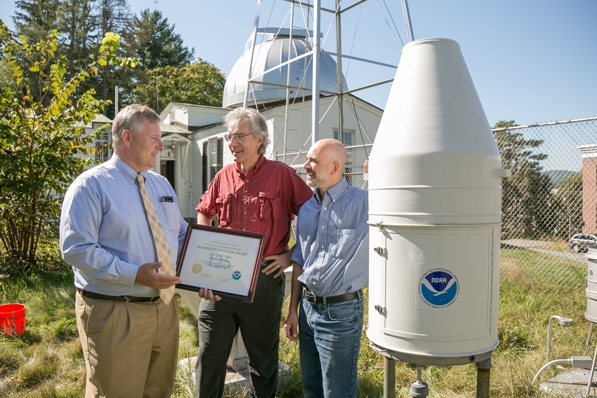Dartmouth is home to any number of sophisticated scientific devices and machines, and then there’s the ruler-in-the-collection-tube rain gauge, a method that has served its purpose so well that its use contributed to the College’s recent award for 125 years of uninterrupted weather monitoring and reporting.

From left, National Weather Service meteorologist Hendricus Lulofs presents the award to Department of Physics and Astronomy Chair James LaBelle and Alan Goldblatt, a teaching lab technician in the department. (Photo by Robert Gill)
Officials from the National Oceanic and Atmospheric Administration’s National Weather Service (NWS) this fall presented the College with an Honored Institution Award for delivering, monitoring, and reporting data to the NWS.
“While we’ve been converting our measurement and record-keeping over to electronic systems, we continue to use the time-tested stick-in-a-tube-of-water method for rainfall,” says Alan Goldblatt, a teaching lab technician in the Department of Physics and Astronomy. “We want to keep the data from the last 125 years continuous with our new data. But the new electronic instruments don’t give the same accuracy as dipping a ruler into the water collection tube, so comparison over the years would not be valid if we switched to the new methods.”
Hendricus Lulofs, meteorologist-in-charge at the NWS forecast office in Gray-Portland, Maine, presented the award on Sept. 17.
“We consider this a significant accomplishment,” says Lulofs.
The award presentation took place outside Shattuck Observatory, which is located on a hill behind the Wilder physics building. The observatory, constructed in 1854, is the oldest scientific building on campus and is the site of a public astronomical observing program that offers public access to Dartmouth telescopes. The observatory’s backyard is filled with a collection of antiquated weather monitoring equipment that represents a historical chronicle of the science.
“Basically the National Weather Service uses cooperative weather sites such as this one, not only to track daily weather, but when you put all these daily observations together over months and then years and then decades and in this case over a century, this really allows us to track climate change,” Lulofs says.
Read More:
Dartmouth is one of approximately 8,700 cooperative weather observation sites within the United States that feed data to 122 NWS forecast offices.
“It is through longevity observation sites such as this one—this is one of the longest out there—that allows us to have actual, factual information that extends back over 100 years in this case,” says Lulofs. “And when you have a collective of these sites all across not only the Northeast but the country, the continent, and around the globe, you actually can start getting a good feel for how weather patterns change throughout the years.”
Physics and Astronomy Chair James LaBelle says he’s pleased that his department has supported the weather data collection program for so long.
“We owe a lot of gratitude to staff member Tom Kenyon who recently retired after a quarter century of service. His dedication and personal interest in weather kept it going for that time. More recently, Alan Goldblatt has shown the same dedication and interest. I hope he’ll carry the football for the next quarter century,” says LaBelle.
